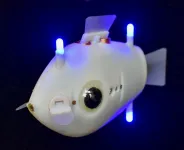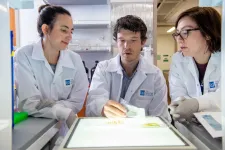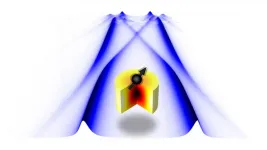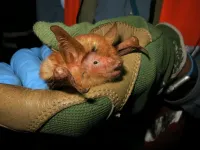How does your computer smell?
Researchers create a highly sensitive biohybrid olfactory sensor
2021-01-13
(Press-News.org) A keen sense of smell is a powerful ability shared by many organisms. However, it has proven difficult to replicate by artificial means. Researchers combined biological and engineered elements to create what is known as a biohybrid component. Their volatile organic compound sensor can effectively detect odors in gaseous form. They hope to refine the concept for use in medical diagnosis and the detection of hazardous materials.
Electronic devices such as cameras, microphones and pressure sensors enable machines to sense and quantify their environments optically, acoustically and physically. Our sense of smell however, despite being one of nature's most primal senses, has proven very difficult to replicate artificially. Evolution has refined this sense over millions of years and researchers are working hard to catch up.
"Odors, airborne chemical signatures, can carry useful information about environments or samples under investigation. However, this information is not harnessed well due to a lack of sensors with sufficient sensitivity and selectivity," said Professor Shoji Takeuchi from the Biohybrid Systems Laboratory at the University of Tokyo. "On the other hand, biological organisms use odor information extremely efficiently. So we decided to combine existing biological sensors directly with artificial systems to create highly sensitive volatile organic compound (VOC) sensors. We call these biohybrid sensors."
Takeuchi and his team essentially grafted a set of olfactory receptors from an insect into a device that feeds certain odors to the receptors and also reads how the receptors respond to these odors. Analysis of electrical signals from the olfactory receptors indicates what molecules triggered the signals. This method yields great sensitivity and is possible thanks to the way the receptors are physically bound within lipid bilayers. In previous experiments such a method has limited the way odors can be delivered to the receptors, but the team created an efficient solution to this problem too.
"The receptors react to molecules in a liquid droplet, so one of the main challenges was to make a device to transplant molecules from their air into these droplets," said Takeuchi. "We designed and fabricated microscale slits underneath where the droplet passes to force this exchange of molecules. By introducing the gas into the microslit, we were able to increase the probability of contact between the gas and the droplet and transfer target molecules to the fluid efficiently."
With this system, the researchers were able to detect traces of the chemical octenol, also called mushroom alcohol, which is known to attract mosquitoes, in the breath of a test subject. Not only that but the VOC sensor could detect concentrations on the order of parts per billion. This is about a thousand times less than the sensitivity of a dog's nose but it is an impressive achievement nonetheless and has inspired the team to keep innovating.
"I would like to expand upon the analytical side of the system by using some kind of AI. This could enable our biohybrid sensors to detect more complex kinds of molecules," said Takeuchi. "Such refinements might help in our goals to not only measure hazardous materials and environmental hazards but maybe even early stages of diseases from patients' breath and body odor."
INFORMATION:
Journal article
Tetsuya Yamada, Hirotaka Sugiura, Hisatoshi Mimura, Koki Kamiya, Toshihisa Osaki and Shoji Takeuchi. Highly sensitive VOC detectors using insect olfactory receptors reconstituted into lipid bilayers. Science Advances. DOI: 10.1126/sciadv.abd2013.
https://advances.sciencemag.org/lookup/doi/10.1126/sciadv.abd2013
Funding
This study is partly supported by the New Energy and Industrial Technology Development Organization (NEDO), Japan, by JSPS KAKENHI Grant Number JP16H06329, by the Program for Building Regional Innovation Ecosystem of MEXT, Japan.
Useful links
Biohybrid Systems Laboratory
http://www.hybrid.t.u-tokyo.ac.jp/en/
Institute of Industrial Science
https://www.iis.u-tokyo.ac.jp/en/
Department of Mechano-Informatics
https://www.i.u-tokyo.ac.jp/edu/course/m-i/index_e.shtml
International Research Center for Neurointelligence
https://ircn.jp/en/
Video on previous research
https://youtu.be/RMW_JJTOnUE
Research Contact
Professor Shoji Takeuchi
(1) Graduate School of Information Science and Technology, The University of Tokyo
7-3-1 Hongo, Bunkyo-ku, Tokyo 113-8656
Tel: +81-3-5841-6488
(2) Institute for Industrial Science
4-6-1 Komaba, Meguro-ku, Tokyo 153-8505
Tel: +81-3-5452-6650 - Email: takeuchi@hybrid.t.u-tokyo.ac.jp
Press Contact
Mr. Rohan Mehra
Division for Strategic Public Relations, The University of Tokyo
7-3-1 Hongo, Bunkyo-ku, Tokyo 113-8654, JAPAN
Tel: +81-3-5841-0876 - Email: press-releases.adm@gs.mail.u-tokyo.ac.jp
About the University of Tokyo
The University of Tokyo is Japan's leading university and one of the world's top research universities. The vast research output of some 6,000 researchers is published in the world's top journals across the arts and sciences. Our vibrant student body of around 15,000 undergraduate and 15,000 graduate students includes over 4,000 international students. Find out more at http://www.u-tokyo.ac.jp/en/ or follow us on Twitter at @UTokyo_News_en.
ELSE PRESS RELEASES FROM THIS DATE:
2021-01-13
Scientists from the Pacific Quantum Center of Far Eastern Federal University (FEFU) figured out how the AFV3-109 protein with slipknot structure folds and unfolds depending on temperature. The protein is typical for the viruses of the oldest single-celled organisms that can survive in the extreme conditions of underwater volcanic sources - archaea. The research outcome appears in PLOS ONE.
Using numerical methods and applying quantum field theory that is unique for the study of proteins, the FEFU scientists have probed into the folding topology (scheme) ...
2021-01-13
DURHAM, N.C. - Most of the revenues extracted from use of the world's oceans is concentrated among 100 transnational corporations, which have been identified for the first time by researchers at Duke University and the Stockholm Resilience Centre at Stockholm University.
Dubbed the "Ocean 100," these "ocean economy" companies collectively generated $1.1 trillion in revenues in 2018, according to research published Wednesday in the journal Science Advances. If the group were a country, it would have the world's 16th-largest economy, roughly equivalent to the gross domestic product (GDP) of Mexico.
"Now that we know who some of the biggest beneficiaries from the ocean economy are, this can help improve transparency relating to sustainability and ocean ...
2021-01-13
Schools of fish exhibit complex, synchronized behaviors that help them find food, migrate and evade predators. No one fish or team of fish coordinates these movements nor do fish communicate with each other about what to do next. Rather, these collective behaviors emerge from so-called implicit coordination -- individual fish making decisions based on what they see their neighbors doing.
This type of decentralized, autonomous self-organization and coordination has long fascinated scientists, especially in the field of robotics.
Now, a team of researchers at the Harvard John A. Paulson School of Engineering and ...
2021-01-13
Philadelphia, January 13, 2021--Researchers at Children's Hospital of Philadelphia and the School of Engineering and Applied Science at the University of Pennsylvania have identified ionizable lipid nanoparticles that could be used to deliver mRNA as part of fetal therapy. The proof-of-concept study, published today in Science Advances, engineered and screened a number of lipid nanoparticle formulations for targeting mouse fetal organs and has laid the groundwork for testing potential therapies to treat genetic diseases before birth.
"This is an important first step in identifying nonviral mediated approaches for delivering cutting-edge therapies before birth," said co-senior author William H. Peranteau, MD, an attending surgeon in the Division of ...
2021-01-13
PHILADELPHIA -- (Jan. 13, 2021) -- Scientists at The Wistar Institute discovered that Early Growth Response 1 (EGR1), a protein that turns on and off specific genes during blood cell development, inhibits expression of pro-inflammatory genes in macrophages. As part of their function to protect the body against pathogens, macrophages play a major role in initiation, maintenance, and resolution of inflammation. The discovery expands the understanding of how macrophages are set off and deactivated in the inflammatory process, which is critical in many normal and pathological conditions. These findings were published online in the journal Science Advances.
"By deepening the understanding of the role of EGR1, we ...
2021-01-13
COLUMBUS, Ohio - While we wait for our turn to get vaccinated against SARS-CoV-2, we could - and probably should - use the time to make sure we bring our healthiest emotional and physical selves to the treatment, a new review of previous research suggests.
Ohio State University researchers reviewed 49 vaccine studies in humans dating back 30 years that document how stress, depression and poor health behaviors can negatively affect the body's immune response to vaccination, and how improving health factors can enhance that response.
The impaired immune responses tended to fall into three categories - interference with the ...
2021-01-13
Skoltech researchers have found a way to use chemical sensors and computer vision to determine when grilled chicken is cooked just right. These tools can help restaurants monitor and automate cooking processes in their kitchens, and perhaps one day even end up in your 'smart' oven. The paper detailing this research results, supported by a Russian Science Foundation grant, was published in the journal Food Chemistry.
How do you tell that chicken breast on your grill is ready for your plate? You probably look at it closely and smell it to make sure it is done the way you like it. However, if you are a restaurant chef or head cook at a huge industrial ...
2021-01-13
Scientists tame photon-magnon interaction.
Working with theorists in the University of Chicago's Pritzker School of Molecular Engineering, researchers in the U.S. Department of Energy's (DOE) Argonne National Laboratory have achieved a scientific control that is a first of its kind. They demonstrated a novel approach that allows real-time control of the interactions between microwave photons and magnons, potentially leading to advances in electronic devices and quantum signal processing.
Microwave photons are elementary particles forming the electromagnetic waves that we use for wireless communications. On the other hand, magnons are the elementary particles forming what scientists call "spin waves" -- wave-like disturbances in ...
2021-01-13
In a study in mice and human cells, Johns Hopkins Medicine researchers say that they have developed a tiny, yet effective method for preventing premature birth. The vaginally-delivered treatment contains nanosized (billionth of a meter) particles of drugs that easily penetrate the vaginal wall to reach the uterine muscles and prevent them from contracting. If proven effective in humans, the treatment could be one of the only clinical options available to prevent preterm labor. The FDA has recommended removing Makena (17-hydroxyprogesterone caproate), the only approved medicine for this purpose, from the market.
The study was published Jan. 13 in Science Translational Medicine.
There ...
2021-01-13
A group of scientists led by the American Museum of Natural History and Bat Conservation International have discovered a new species of a striking orange and black bat in a mountain range in West Africa. The species, which the researchers expect is likely critically endangered, underscores the importance of sub-Saharan "sky islands" to bat diversity. The species is described today in the journal American Museum Novitates.
"In an age of extinction, a discovery like this offers a glimmer of hope," said Winifred Frick, chief scientist at Bat Conservation International and ...
LAST 30 PRESS RELEASES:
[Press-News.org] How does your computer smell?
Researchers create a highly sensitive biohybrid olfactory sensor





